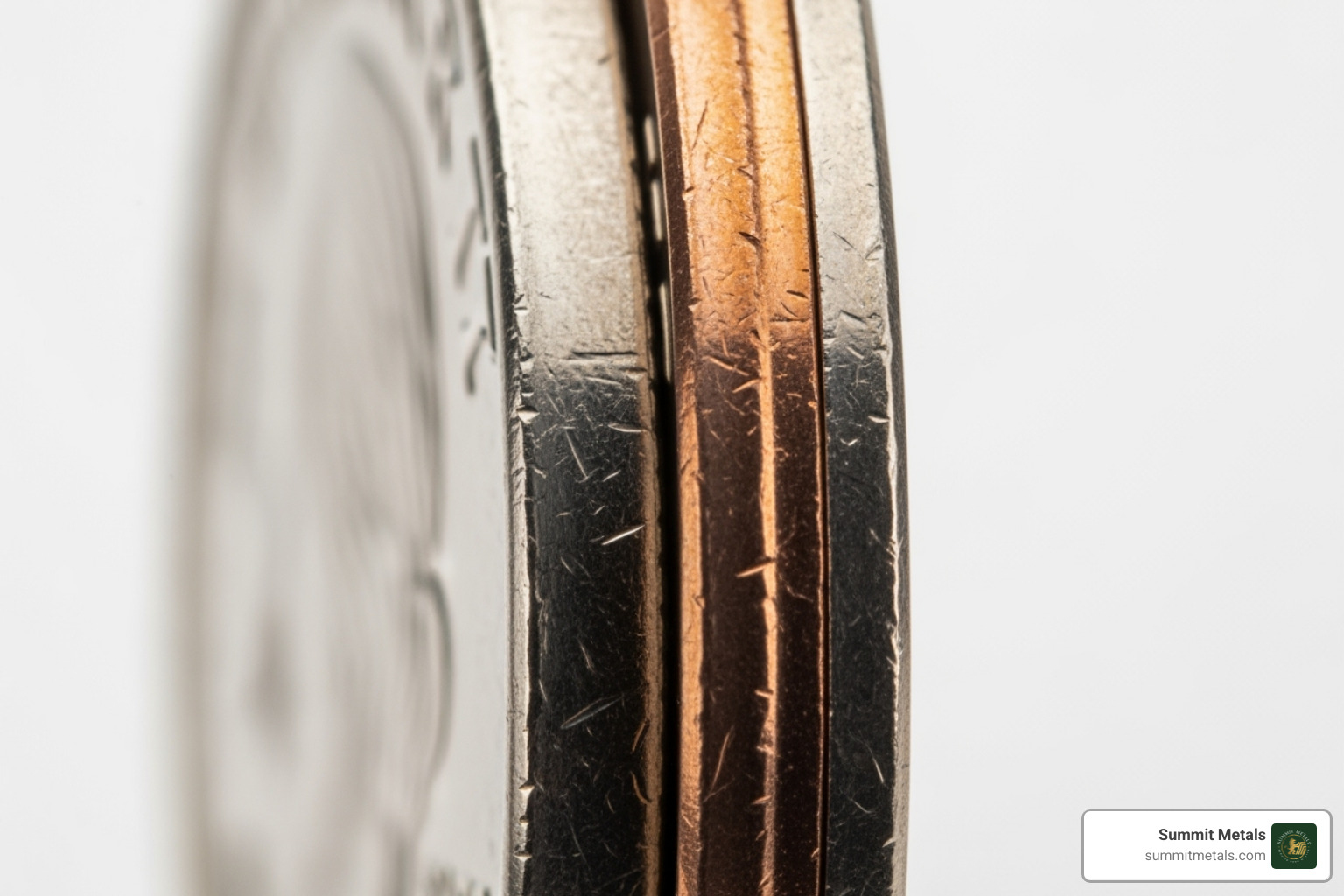Why Junk Silver is Called "Real Money"
Junk silver refers to circulated U.S. silver coins minted before 1965. They contain 90% pure silver but have no collectible value beyond their metal content. Despite the name, these coins represent tangible wealth, valued by investors for their intrinsic silver content, divisibility, and recognizability.
Quick Facts About Junk Silver:
- Composition: 90% silver, 10% copper (most pre-1965 U.S. dimes, quarters, half dollars, and dollars)
- Value Basis: Silver content, not face value or collectible rarity
- Common Types: Roosevelt & Mercury dimes, Washington quarters, Walking Liberty & Franklin half dollars, Morgan & Peace dollars
- Silver Content: Every $1.00 face value contains approximately 0.715 troy ounces of pure silver
- Why "Junk"? The term refers to a lack of numismatic (collectible) value due to wear, not the quality of the silver.
Junk silver represents our last circulating currency backed by physical precious metal. These coins were minted with a 90% silver alloy through 1964, before the U.S. Mint transitioned to cheaper cupro-nickel alloys. The term "junk" is misleading--these coins hold real value. Many investors prefer calling them "constitutional silver" because they were once legal tender backed by the U.S. government's commitment to precious metal content. Today, they are an affordable entry point into fractional silver ownership, with lower premiums than modern .999 fine bullion.
This guide will cover everything you need to know about junk silver value, from calculation and portfolio strategy to authentication.
I'm Eric Roach. With over a decade of experience in risk management for Fortune-500 clients, I help everyday investors use physical assets like junk silver to build resilient portfolios. My experience translates into clear strategies for acquiring and valuing junk silver as part of a diversified wealth-protection plan.

What is Junk Silver? Unpacking the "Junk" and "Constitutional" Labels
The term junk silver is a misnomer. These coins are called "junk" simply because they lack numismatic (collectible) value due to wear from circulation. Their real value lies in their silver content, which remains intact regardless of scratches or dings.
Defining "Junk" vs. "Constitutional" Silver
Many investors prefer the term "constitutional silver." These coins were minted as legal tender under the U.S. Constitution, representing the last generation of American money backed by actual silver. This gives them a legitimacy that modern fiat currency lacks. A worn 1964 quarter contains just as much silver as a pristine one--the metal's value is what matters.
For a deeper understanding of this historical significance, check out our guide on Constitutional Silver Junk Silver and explore the history of US currency.
Historical Context: The Coinage Act of 1965
The story of junk silver begins in the 1960s. As silver prices climbed, the metal in U.S. dimes, quarters, and half dollars became worth more than their face value. This led people to hoard them, an example of Gresham's Law ("bad money drives out good").
To combat the resulting coin shortage, Congress passed the Coinage Act of 1965. This act removed silver from dimes and quarters, replacing it with a cheaper cupro-nickel alloy. The Kennedy Half Dollar retained 40% silver from 1965 to 1970 before it also became a clad coin. This transition marked the end of circulating precious metal currency in the U.S. The pre-1965 survivors are what we now call junk silver.
You can spot the difference by looking at a coin's edge. Pre-1965 silver coins have a solid silver edge, while post-1965 clad coins reveal a distinct copper stripe.

Common Types and Purity of Junk Silver Coins
Understanding the different types of junk silver helps in making smart purchases.
- 90% Silver Coins (pre-1965): This is the most common and desirable category. It includes Roosevelt and Mercury Dimes, Washington Quarters, and Walking Liberty, Franklin, and 1964 Kennedy Half Dollars. Morgan and Peace Dollars also contain 90% silver but often carry numismatic premiums.
- 40% Silver Coins (1965-1970): This category consists of Kennedy Half Dollars from this period. They are less popular with investors due to lower silver content and liquidity.
- 35% Silver "War Nickels" (1942-1945): Minted during WWII, these Jefferson Nickels contain 35% silver. They are identifiable by a large mint mark (P, D, or S) above Monticello on the reverse.
For most investors, 90% silver coins offer the best combination of silver content, recognizability, and liquidity. They are the focus of this guide and are widely available from reputable dealers like Summit Metals.
How to Determine Junk Silver Value
Understanding how to value your junk silver is essential. The good news is that the math is simple.
The Role of Silver Spot Price and Premiums
The value of junk silver is based on its melt value, which is tied directly to the silver spot price--the real-time market price for one troy ounce of pure silver. However, you will always pay a premium over the spot price.
Premiums cover the costs of minting, distribution, and dealer overhead. They fluctuate based on supply and demand, coin type (e.g., more desirable Mercury Dimes), and dealer pricing. Summit Metals keeps premiums competitive through bulk purchasing and transparent pricing. For a deeper dive, check out An Essential Guide to Valuing Constitutional Silver.
Calculating the Value of Your Junk Silver

Here's the key formula: every $1.00 of face value in 90% junk silver contains approximately 0.715 troy ounces of pure silver. A common rule of thumb is that $1.40 in face value equals about one troy ounce of pure silver.
Here's how to calculate the value of 90% junk silver:
Total Silver Value = (Face Value x 0.715) x Current Silver Spot Price
For example, with $10.00 face value and silver at $25.00/oz: ($10.00 x 0.715) x $25.00 = 7.15 x $25.00 = $178.75
This is the melt value. When buying, you'll pay this plus a premium. When selling, you might receive slightly less. For valuing larger quantities, see our guide on How Much is a Pound of Silver Worth?.
Junk Silver vs. Numismatic Coins vs. Silver Bullion
Each type of silver serves a different purpose. This chart breaks down the differences:
| Feature | Junk Silver | Numismatic Coins | .999 Silver Bullion |
|---|---|---|---|
| Purity | Typically 90% (also 40% or 35%) | Varies (often 90%+) | 99.9%+ |
| Value Basis | Melt value (silver content) | Rarity, condition, history | Melt value (silver content) |
| Premiums | Generally low | Can be very high | Moderate |
| Liquidity | High for 90% coins | Varies; specialized market | High |
| Counterfeit Risk | Low for common coins | Moderate to high | Moderate |
| Recognizability | Very high (former U.S. currency) | Varies; requires knowledge | High (well-known coins) |
| Divisibility | Excellent (small denominations) | Poor (high value per piece) | Good (rounds, small bars) |
Junk silver is a practical workhorse, offering silver's intrinsic value without the high premiums of numismatic coins. Modern .999 fine silver bullion offers maximum purity, but junk silver occupies a sweet spot of affordability, authenticity, and flexibility. For more on how grading affects value, see The Value of Perfection: Graded Silver Eagles Explained.
With Summit Metals, you can mix and match based on your goals. Dollar-cost averaging through consistent monthly purchases--much like a 401(k)--helps smooth out price volatility and builds your stack steadily over time.
Investing in Junk Silver: Strategies and Advantages
Junk silver occupies a unique and valuable space in any investment strategy focused on building a resilient portfolio.
Key Advantages Over Other Silver Forms
Junk silver offers a unique combination of benefits:
- Divisibility: In a barter scenario, small-denomination dimes and quarters are far more practical for everyday transactions than a large silver bar.
- Recognizability: The familiarity of U.S. coinage provides instant credibility and trust, unlike privately minted rounds that may require explanation.
- Lower Premiums: Premiums on junk silver are typically lower than on modern bullion coins like Silver Eagles, meaning you get more silver for your dollar.
- Authenticity: As former U.S. Mint products, these coins have a government-backed authenticity that makes them a trusted asset. Counterfeiting is less common due to lower profit margins.
To explore other silver options, check out our guide on where to purchase silver rounds.
Building Your Stack: Acquisition and Autoinvest Strategies
While you could hunt for silver coins at banks, the most efficient method is to work with a reputable dealer like Summit Metals. We offer junk silver in bulk bags by face value, providing the best value to build your position quickly. For more tips, see our Junk Silver Coins: Your Go-To Guide for Smart Purchases.
A powerful strategy for building your holdings is dollar-cost averaging through Autoinvest. This approach mirrors how you'd contribute to a 401(k): you invest a fixed amount each month. When prices are high, you buy less; when they dip, you buy more. This smooths out volatility and lowers your average cost per ounce over time. Our Autoinvest program makes this effortless. Set it up once to consistently build your junk silver stack without timing the market--a "set it and forget it" approach our clients in Wyoming and Salt Lake City appreciate for building tangible wealth.
The Role of Junk Silver in a Diversified Portfolio
Junk silver is not a get-rich-quick scheme; it's a foundational asset for portfolio protection. It serves as:
- An Inflation Hedge: As fiat currencies lose purchasing power, physical silver tends to maintain its value.
- A Safe Haven: During economic instability, precious metals are a reliable store of value. Junk silver is an accessible form of this protection.
- A Tangible Asset: Unlike stocks and bonds, which are digital promises, junk silver is a physical asset you hold, independent of the financial system. This provides genuine peace of mind.
- Diversification: Precious metals often move counter to stocks and bonds, reducing overall portfolio volatility.
For more on the fundamentals of silver investing, our Beginners Guide to Silver Properties is an excellent starting point.
Risks and How to Authenticate Your Coins
While junk silver is a relatively safe investment, knowing how to authenticate coins and avoid common risks is crucial. Authenticating junk silver is much easier than verifying modern bullion or rare numismatic coins.
Identifying Genuine Junk Silver Coins
Here are five simple tests to verify your coins:
- Check the Date: Dimes, quarters, and half dollars should be dated 1964 or earlier. War Nickels are dated mid-1942 to 1945 with a large mint mark (P, D, or S) on the reverse.
- Examine the Edge: A genuine 90% silver coin has a solid, uniform silver edge. A copper stripe indicates a modern clad coin. (Note: 40% silver Kennedy Halves from 1965-1970 will show a clad edge).
- Try the Ping Test: Tap a silver coin gently. It will produce a clear, high-pitched ring, unlike the dull "thunk" of a clad coin.
- Verify Weight: Use a digital scale. A silver dime weighs 2.5g, a quarter 6.25g, and a half dollar 12.5g. Significant deviations are a red flag.
- Use a Magnet: Silver is not magnetic. If a coin sticks to a magnet, it's a fake.

Common Risks and How to Avoid Them
Be aware of these potential pitfalls:
- Counterfeits: Though less common for junk silver, fakes exist. The best defense is buying from a reputable dealer like Summit Metals, who provides an authenticity guarantee.
- High Premiums: Always know the current silver spot price. If a dealer is charging excessively high premiums for common junk silver, walk away.
- Condition Hype: The value of junk silver is its metal content, not its condition. Don't pay extra for circulated coins based on claims of collectible value.
- 40% Silver Coins: Kennedy Half Dollars from 1965-1970 can be harder to sell and may have less favorable pricing. It's often best to focus on 90% silver coins first.
To protect yourself further, read our guides on How to Avoid Common Precious Metals Scams and Beginner Gold and Silver Selling Mistakes and How to Avoid Them. At Summit Metals, we believe an educated investor is a successful one. We back every coin with our guarantee, transparent pricing, and a commitment to your success.
Frequently Asked Questions about Junk Silver
Here are answers to the most common questions about junk silver investments.
Are Morgan and Peace dollars considered junk silver?
It depends on the condition. While these 90% silver dollars (Morgan: 1878-1921; Peace: 1921-1935) have the right composition, most carry a numismatic (collectible) premium far above their melt value. Only heavily worn or damaged "cull" condition dollars, which have lost their collectible appeal, are truly considered junk silver and priced near their silver content. To learn more about these iconic coins, see our guide on Silver Freedom: Top Deals on Liberty Silver Dollars.
How much junk silver equals one troy ounce?
Approximately $1.40 in face value of 90% silver coins contains one troy ounce of pure silver. Another way to calculate this is that every $1.00 in face value contains about 0.715 troy ounces of silver. This common approximation accounts for the minor weight loss from circulation that these coins have experienced.
Is it better to buy junk silver or .999 fine silver bars?
It depends on your goals, as both have a place in a diversified portfolio.
- Junk Silver: Best for divisibility, recognizability, and bartering. The small denominations and familiar designs make them ideal for small transactions. Premiums are also generally low, making them an accessible starting point.
- .999 Fine Silver Bars: Best for accumulating the maximum amount of pure silver for your dollar. Bars typically have lower premiums per ounce than coins, making them cost-effective for "stacking" large quantities.
You don't have to choose. Many clients use our Autoinvest program to dollar-cost average into both junk silver and silver bars. This strategy of making consistent monthly purchases, like a 401(k), builds a flexible portfolio and smooths out price volatility over time.
Conclusion
Junk silver is anything but junk. These pre-1965 U.S. coins represent real money backed by real metal. Their affordability, divisibility, and government-backed authenticity make them an ideal investment for both new and experienced investors. As a tangible hedge against inflation and economic uncertainty, junk silver provides a level of security that paper assets and digital currencies cannot match.
At Summit Metals, we make precious metals investing straightforward and trustworthy. Based in Wyoming and serving clients from Salt Lake City to across the nation, we provide authenticated gold and silver with transparent, real-time pricing. Our bulk purchasing power ensures competitive rates, putting more metal in your hands.
Whether you're making your first purchase or setting up an Autoinvest program to build your stack over time--much like a 401(k)--we are here to help. Consistent monthly purchases are a proven strategy for building wealth steadily.
Start building your tangible asset portfolio today. Explore our collection of Constitutional Silver and take a crucial step toward financial resilience.



